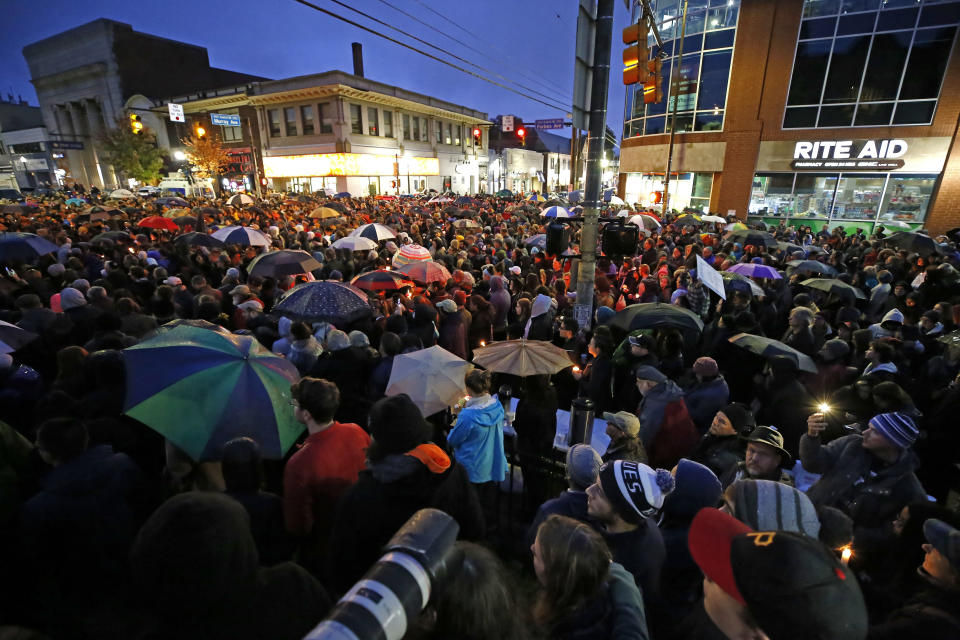The synagogue massacre was actually in Mister Rogers's neighborhood. What would he say?

- Oops!Something went wrong.Please try again later.
The irony that the real-life neighborhood of Mister Rogers was the site of a hate-inspired mass shooting was lost on few people.
Fred Rogers lived in and filmed “Mister Rogers’ Neighborhood” in the historically Jewish Pittsburgh neighborhood of Squirrel Hill, where an anti-Semite opened fire at a Saturday morning service in the Tree of Life synagogue, killing 11 worshipers. Two other congregants and four police officers were injured. Rogers’s connection to the area quickly spread throughout the country but it was already well-known throughout greater Pittsburgh.
The Fred Rogers Center for Early Learning and Children’s Media at Saint Vincent College in Rogers’s hometown of Latrobe, Pa., 40 miles east of Pittsburgh, is dedicated to preserving Rogers’s legacy and fostering research in early childhood development and education based on his philosophy.
Karen Struble Myers, a spokeswoman for the Fred Rogers Center, was finishing her morning coffee at home before leaving for the day when she saw a breaking news alert from a local television station on Facebook about the shooting.
“I was worried and frightened for the community because I know so many people in Squirrel Hill. There is also a certain amount of disbelief that anything of this magnitude would ever happen in such a peaceful, community-minded neighborhood, and then of course, there is the connection to Fred Rogers,” Myers told Yahoo News.

“Mister Rogers’ Neighborhood” ran on public television from 1968 until 2001 — he died in 2003 — and a documentary about his life titled “Won’t You Be My Neighbor?” that was released this year revived interest in his work and worldview, particularly in light of the current political climate. As seen in the film, Rogers delivered a special message to children after the 9/11 terrorist attacks. Since the recent tragedy struck so close to home, his fans are wondering what words of comfort he might have in this situation.
“Despite the deep grief in neighborhoods across the country, he would encourage us, just as he did after 9/11, to be good neighbors and to help the children in our lives to feel safe,” Myers said. “His affirming message about our inherent likeability and worth would bring comfort to many.”
The Anti-Defamation League said the Pittsburgh shooting is believed to be the deadliest attack on the Jewish community in American history. Those less familiar with Rogers might not know that he was a devout Christian with a deep appreciation for the wisdom of various faith traditions, including Judaism.
“Fred Rogers was a deeply spiritual person. Although he was ordained as a Presbyterian minister, he also studied Buddhism, Catholicism, and Judaism,” Myers said. “Most of his reading for personal enjoyment was focused on learning about other religions. Fred worked extensively with his friend Rabbi Earl Grollman on the series of programming about divorce, and he based ‘The Giving Box’ on Jewish tradition.”

Rogers came up with “The Giving Box” to help families create their own traditions of giving and receiving so children can learn how to be good givers and receivers from their parents. He was inspired by the Jewish tradition of the Tzedakah Box, which promotes charity.
In 1997, Rogers spoke to the American Jewish Committee. The full transcript of his speech is at the center, but archivist Emily Uhrin told Yahoo News that a specific line jumped out to her as fitting for this moment.
“What a privilege to be in the company of those who personify hope for the next generation!” Rogers said. “You show the world what the opposite of hate looks like.”
The center’s staff will spend the next week contributing to and participating in the many events to mourn the loss of Saturday’s victims, promote unity and celebrate diversity.
Roberta Schomburg, the Fred Rogers Center’s interim executive director, is taking part in a panel on WQED, a PBS-affiliated television station in Pittsburgh, on how families and caregivers can support children during national tragedies.
Read more from Yahoo News:



